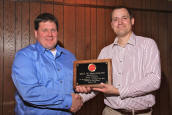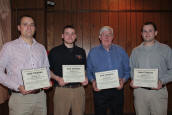Brown Marmorated Stink Bug
Threatens Biological Mite
Control in Pennsylvania
Apple Orchards
UNIVERSITY
PARK, PA, March 10, 2011
/24-7PressRelease/ -- A Penn
State biological control
program that saves apple
growers over $1 million in
insecticide use each year is
being threatened by the
expected increase in
pesticide use due to a new
invasive pest, the brown
marmorated stink bug.
Tree fruit is a $70 million
a year industry in
Pennsylvania, with the
majority of the fruit being
grown in the southern part
of the state. With the help
of the Pennsylvania State
University Fruit Research
and Extension Center,
family-owned Lerew Farms,
Inc. became one of the first
growers in the state to move
away from broad-spectrum
insecticides and transition
to more pest selective and
environmentally safer
insecticides in the
mid-1990s using integrated
pest management
(IPM).
Pennsylvania's Integrated
Pest Management Program has
resulted in apple growers
using fewer and safer
pesticides. IPM promotes the
use of safer and more
environmentally compatible
pest control practices.
At Lerew Farms, which has
about 1,000 acres of fresh
market apples and processing
tart cherries, Penn State
tree fruit entomologist Dr.
David Biddinger discovered
increasing numbers and
diversity of beneficial
insects in orchards. These
beneficial insects
significantly reduce
outbreaks of secondary
pests, such as mites, aphids
and leafminers. According to
Biddinger, most striking was
the lack of outbreaks by the
European red mite, a major
target of pesticides in the
past. "Most growers were
averaging about $150 to $200
per acre in insecticide and
miticide costs with about
one third being spent just
to control mites."
In addition, Dr. Biddinger
discovered a new mite
predator, Typhlodromus pyri,
never before seen in
Pennsylvania orchards.
Effective biological mite
control programs in apple
using T. pyri existed in
parts of New York, New
England and Washington, but
never in the Mid-Atlantic
States despite several
intensive surveys. "It was
generally thought that T.
pyri is a cool region
predator that could not
adapt to a warmer climate,
but an intensive survey of
other Pennsylvania fruit
farms found it to be present
at lower levels on a number
of other farms that were
using mostly selective
insecticides," Biddinger
said.
IPM creates an orchard
environment where natural
enemies of pests can
survive. Unlike other mite
predators, T. pyri spends
its entire life on the tree
so that a toxic insecticide
application anytime during
the season would wipe out
the population. "Because T.
pyri never leave the tree,
it is a more effective mite
predator," Biddinger
explains."In addition, T.
pyri has the unique ability
to feed pollen and fungal
spores at times when the
pest mite prey were very
low. Other mite predators
can't do this and only move
back into the orchard when
pest mite populations are
high and already causing
significant damage."
Once T. pyri was discovered
at the Lerew orchard,
researchers transferred
branch clippings to other
orchards in the spring and
fall. "Using Lerew's and the
Penn State research orchards
as two T. pyri 'seed sites',
we quickly established the
predator in the majority of
Pennsylvania's 22,000 acres
of apples," said Biddinger.
It is estimated that this
conservation biological
control program is
seasonally reducing miticide
use in Pennsylvania apple
orchards by almost a ton and
saves growers over $1
million a year. Not only was
controlling mites with
miticides expensive for
growers, but also it was
non-sustainable since the
pest mites developed
resistance to all new
products within three to
five years.
The project was facilitated
by financial incentives
provided to the growers
through USDA-Natural
Resources Conservation
Service (NRCS) conservation
programs and through
conservation guidelines
provided by Penn State. T.
pyri from the original Lerew
Farms site have now been
spread and established in
Maryland, Virginia and West
Virginia through similar
USDA-NRCS conservation
programs.
Unfortunately, the entire
tree fruit IPM system is
being threatened by a new
pest. In 2010, brown
marmorated stink bug (BMSB)
moved into the mid-Atlantic
fruit-growing region and did
extensive damage to apple
and peach crops. Some
growers lost 40 percent or
more of their crop.
Researchers know very little
about managing BSMB since
this insect is a recent
arrival from China and has
just begun to severely
affect agriculture.
According to Biddinger,
fruit growers are faced with
a terrible choice:
extensively and frequently
spraying with broad spectrum
insecticides to ensure
control of BSMB, or not
extensively spraying to
preserve the IPM system, but
risking yield losses and
lower profits from BSMB
damage. "In either case the
cost of production will rise
or the supply of apples will
decline maybe resulting in
higher prices for the
consumer."
Research programs
investigating safer and
cheaper ways to control BSMB
are starting, but scientists
have much to learn. "In the
meantime, fruit growers will
do the best they can to
manage pests in a safe way,
while hopefully not going
out of business," says
Biddinger.
Current PSU recommendations
for establishing and
conserving biological mite
control with T. pyri are
annually updated at:
http://extension.psu.edu/ipm/resources/nrcs/programs/conventreefruit/
... mites/view and a
more complete report on the
discovery and development of
T. pyri in Pennsylvania can
be found at:
http://extension.psu.edu/ipm/resources/nrcs/presentations/mite-control/view.
For more information on tree
fruit IPM, contact Dr. David
Biddinger at (717) 677-6116
or by e-mail at
djb134@psu.edu
Casey Statement on Gas
Pipeline Safety After
Meeting with UGI
WASHINGTON,
DC—U.S. Senator Bob Casey
(D-PA) today released the
following statement after
meeting with UGI Utilities
President and CEO John Walsh
to discuss pipeline safety
in the wake of the pipeline
explosion last month in
Allentown:
“Today, I
continued to impress upon
UGI the need to conduct a
thorough investigation of
the tragedy in Allentown and
to keep the public informed
of the investigation. I
also pressed UGI on taking
every practicable step to
prevent another tragedy from
happening. Both the private
sector and the public sector
need to direct greater
resources towards
accelerating the replacement
of aging pipelines. We can
replace pipelines, but we
cannot replace lives.
Federal and state agencies
as well as public utilities
also need to perform
ongoing, comprehensive
inspections and provide
information to consumers
about pipeline safety.
“I will
continue to push for an
increased focus on pipeline
safety by federal and state
authorities and companies.
And I will closely monitor
the progress of UGI’s
investigation and its
actions to correct problems
with gas pipelines.
“If anyone
has questions about gas
pipes in their area, I
encourage them to visit
UGI’s disaster response Web
site at
www.ugiresponse.com.”
Casey
Column: House Should Pass No Budget, No Pay Bill
WASHINGTON,
DC— U.S. Senator Bob Casey (D-PA), Chairman of
the Joint Economic Committee, and Senator
Barbara Boxer (D-CA) wrote a column that was
published in today’s Politico that urged House
Speaker John Boehner (R-OH) to quickly pass a
version of their Senate-passed bill that would
prevent Congress and the President from being
paid in the event of a government shutdown. The
full text of the column is below:
House Speaker
John Boehner (R-Ohio), in a recent speech in
Nashville, Tenn., said it was our “moral
responsibility” to avoid a government shutdown.
We couldn’t
agree more. So we are now urging him to take a
critical step to help take the threat of a
government shutdown off the table.
The Senate
last week unanimously passed our legislation
that would prevent lawmakers and the president
from being paid during a government shutdown. A
similar bill has been introduced in the House by
Rep. Jim Moran (D-VA).
Now is the
time for the speaker to show that he means what
he says by bringing this important bill up for a
vote in the House.
While we may
not agree on everything in this budget,
lawmakers from both parties should agree on
this: If we cannot fulfill our most basic
responsibility to keep the government operating,
we should not receive a paycheck.
It’s a
little-known fact that members of Congress and
the president are not treated the same as
millions of other federal employees — because
we’re paid through mandatory spending, rather
than annual appropriations. In the event of a
government shutdown, we would be among the few
to continue receiving paychecks.
It’s unfair
that members of Congress or the president would
be paid while millions of other workers who
serve the American people would see their
paychecks cut off and have to struggle to pay
their bills.
Our bill could
fix this inequity. It would also go a step
further, saying that lawmakers and the president
should not be paid retroactively after a
shutdown. The message could not be clearer: No
budget, no pay.
Boehner
supported this same legislation back in 1995,
telling a CNN interviewer, “I’d be happy to sign
onto that bill right now.” The Boxer-Durbin bill
passed the Senate, but was blocked by the House.
The American
people have a right to expect that Congress will
do its work. That means making sure that
essential services are not interrupted because
of partisan politics.
Social
Security checks should not be delayed. Veterans’
benefits should not be disrupted. Passports
should continue to be issued. Superfund sites
should be cleaned. Oil wells should be
inspected. Export licenses should be granted.
All this would be threatened in a shutdown.
A government
shutdown would be a disaster for our nation and
our economy. We must end the threat once and for
all — and begin work on a responsible budget
that will reduce the deficit without putting our
economic recovery at risk. Failing to do so
would be an abdication of our most fundamental
responsibility.
That’s why, in
a bipartisan spirit, all Democrats and
Republicans joined together to pass our bill in
the Senate. Now it is time for Boehner to put
this “no budget, no pay” bill on the House floor
for a vote without delay.
Sen. Barbara
Boxer (D-CA) is the chairwoman of the
Environment and Public Works Committee and
chairwoman of the Select Committee on Ethics.
Sen. Bob Casey (D-PA) is the chairman of the
Joint Economic Committee.
Mandated
Change In Light Bulbs To
Occur At Year's End
University Park, Pa. -- Get ready
for some mandated
changes in
lighting, warns an energy expert
in Penn State's College of
Agricultural Sciences.
Effective Jan. 1, 2012, it will be
a federal offense for any company, organization or
individual
in the United States to manufacture or import 100-watt
incandescent light bulbs for
general-use lighting. Dennis Buffington,
professor of agricultural engineering,
said California already has banned the 100-watt
incandescent bulbs starting
this year. The reason for the ban is the availability of other lighting
alternatives today that are considerably more energy-efficient than
the incandescent bulbs.
"You can continue
using your 100-watt
incandescent bulbs next year, and
you can replace those bulbs with other 100-watt
incandescents that you may have
in inventory,"
Buffington said. "But you will be
unable to purchase the bulbs after Jan. 1, 2012.
In fact, you may not be able to find
them in stores during
the last few months of 2011."
Smaller sizes of
incandescent bulbs for general use
will be banned at later dates. Effective Jan. 1, 2013, 75-watt
incandescent bulbs will face a
similar ban; the 60-watt and 40-watt incandescents
will be banned effective Jan.1, 2014.
"Specialty
incandescent bulbs will not be
subject to these bans," Buffington
said. "Specialty bulbs include
three-way bulbs, appliance lights, 'bug lights,' colored bulbs,
vibration-service and rough-service bulbs, and bulbs used for marine
and mining applications."
When searching
for an alternative to incandescent
bulbs, Buffington advised, evaluate
the lights on the basis of lighting
efficiency, expressed as lumens per watt. The wattage rating
of a bulb merely indicates the
wattage of electricity required for input
to the bulb. The light output is measured
in lumens. Thus, lighting
efficiency is expressed as lumens per watt.
"The compact fluorescent lamp (CFL)
produces about four times the amount of light that an
incandescent bulb produces on a
per-watt basis," Buffington explained.
"An additional benefit is that the CFL has a life span of about
10,000 hours versus 1,000 hours for a typical
incandescent. A disadvantage of the
CFL is that the bulb contains both
mercury and lead -- potentially hazardous heavy metals."
Although CFL bulbs contain
significantly less mercury and lead than they did a decade ago, the
bulbs still must be handled in a
responsible manner for disposal, Buffington
cautioned. Most "big box" home improvement stores now have drop-off
sites for proper disposal of the burned-out CFL bulbs, he pointed
out.
CFLs now are available
in many different sizes, shapes and
colors of light (soft white, cool white, warm glow, etc.). The
typical CFL sold today is a coiled tube, although some are available
with an outer glass shell that hides the coil. The bulbs with the
covered coils look like incandescents
but with the efficiency and long life of CFLs.
"CFLs that can be used with dimmer
switches now are available," Buffington
said. "Be careful though. Only the CFLs that are labeled as dimmable
on the packaging will function
properly when used with a dimmer switch.
"LED (light-emitting
diode) bulbs are even more efficient than the CFL, and the life of
an LED is longer than the CFL," he said. "LEDs are free of both
mercury and lead. But I do not recommend LEDs today simply because
they still are too expensive, although the prices have dropped
in recent years. I anticipate
significant reductions in the price
of LEDs within the next five years
or so, and then they may be feasible lighting
alternatives."
Causer Says Corbett Budget Marks Needed Step
Toward Fiscal Responsibility
Rep. Martin Causer (R-Turtlepoint) said the 2011-12 state budget proposal
presented by Gov. Tom Corbett on Tuesday is a difficult but important first step
toward adopting a fiscally responsible spending plan.
“For the first time in eight years, we will finally cut spending,” said Causer,
a member of the House Appropriations Committee. “State government has been
living beyond its means for far too long; that will finally come to an end this
year.
“There is no question that some of the cuts the governor is proposing are
painful, and as a member of the House Appropriations Committee, I will be taking
a very careful look at those cuts and their potential impact on our communities
and our citizens,” he continued. “In the end, we have no choice but to cut
spending. It’s what the people want, and it’s up to us as lawmakers to make the
tough decisions we need to achieve that goal.”
Corbett’s $27.3 billion budget proposal represents a spending reduction of 3.1
percent, or $866.3 million, when compared to the current year’s budget.
Over the next three weeks, Causer and members of the House Appropriations
Committee will question administration officials representing all state
departments and agencies about their budget needs in an effort to identify
additional cuts or funding needs. Based on the information gathered, a budget
bill will be introduced into the state House for debate.
A budget must be passed by the end of the fiscal year, June 30. After eight
straight years of late budgets during the Rendell administration, Causer said he
and legislative leaders are committed to getting the job done on time.
“From day one, my priorities have been to pass an on-time,
fiscally responsible budget with no new or increased taxes,” Causer said. “We
will examine the governor’s proposal in detail over the coming weeks and months
to develop the best possible blue print for the Commonwealth’s future.”
Borough
Council Gets Earful Of Snow
by Martha Knight
The Port Allegany Borough Council meeting was lively and well
attended, Monday night, as borough residents, business persons and employees
were on hand to weigh in on snow removal and related issues.
 Lucas Johnson led off the discussion by describing how lack of
access for fire fighters and equipment had hampered control of an Arnold Avenue
fire, and resulted in damage to his garage, located near the structure where the
main blaze was located.
Lucas Johnson led off the discussion by describing how lack of
access for fire fighters and equipment had hampered control of an Arnold Avenue
fire, and resulted in damage to his garage, located near the structure where the
main blaze was located.
Sue Barnett, who operates the Northern Tier Children’s Home thrift
shop in the south block of the Main Street business district, described her
frustration during the height of the snow accumulation from the resent storm.
She said customers were unable to reach the NTCH store, and she had to close it
for the day.
PennDOT plows Main Street, which coincides with Route 6 and State
Route 155 in the borough. Barnett said she had called PennDOT officials and
Assemblyman Marty Causer’s office. She saw borough snowplows traveling
Main Street but had been told the local crew was not assigned to plow that
street or the area in front of her store.
Barnett said she realizes that PennDOT is responsible for the
street, but believes the borough could deal with the snow during crisis
snowfalls. “If you want to keep business in town,” Barnett said, the
borough must make sure the streets and sidewalks are passable. They could
help out along Main Street “as a courtesy,” she suggested. She said the
owners of NTCH will close the store if she has more days when it cannot do
business. She has two employees in the shop. There are residential
tenants on the second floor.
Later borough manager Richard Kallenborn said that he had spoken
with PennDOT officials who outrank those who had spoken with Barnett, and
contrary to what they had told her, the PennDOT crews will plow in the business
section even before finishing the rest of Route 6 in the area. He said it
would be a matter of notifying those in charge.
Keith Fortner, CEO of First National Bank of Port Allegany,
confirmed that changes in traffic patterns are a factor in worsening snow
control. He said persons coming into the community from out of town have
commented that the street situation seems worse than in some nearby communities.
Fortner suggested that it might be necessary to allocate more funds
for snow and ice control.
Council member Dave Fair commented on the number of hill streets
and wondered whether they were plowed as promptly as the level streets, drawing
a query from one of the borough crew members present, “Where would you like us
to start?”, which rankled Fair.
The crew members said the borough has only one truck capable of
plowing the hill streets.
The responsibility for owners or tenants to clear snow from the
public sidewalks along their properties was mentioned, with regard to
enforcement of the local ordinance, and the lack of compliance along the south
block of the business section. Most storefronts in that block are vacant.
Mayor Don Carley said he agrees that the snow removal situation is
a valid concern. Code enforcement officer Dan Dzubak said he has issued
warnings but has not given citations and does not know whether the district
magistrate would fine people for such violations.
One crew member, mentioning his own many years of service, said the
current borough manager is the best manager he has served, because of his
knowledge concerning the borough infrastructure and willingness to work with the
crew members. Other employees present said they agree.
Present for the meeting was Claudia Camanite, WalkWorks project
coordinator, who described her grant funded program. She distributed maps
of the route she said would be used for a health benefitting walking program,
and secured agreement by the council to erect flags making the ends of trails.
The University of Pittsburgh Center for Rural Health Practice is in
charge of the WalkWorks program, Camanite explained, in a presentation to the
council.
Council adopted a resolution approving the disposal of certain
municipal records. Fortner noted that the bank has scheduled a visit by a
shredding service mobile unit in April and offered to have it handle the
borough’s document disposal at that time.
Another offer by Fortner was to allow borough officials to use the
bank’s PortAllegany.com website to post public service announcements. He
said borough office personnel could be shown how to handle uploads in short
order.
Liberty Twp Supers Put “Or Else” In
Sewer Bill Collection
by Martha Knight
LIBERTY VILLA — Where sewer customers
are not also water customers, it can be difficult to shut off service for
nonpayment of sewer bills.
That has been the situation in Liberty
Township, where there are numerous sewer customers who are not water customers,
and a small number of them have fallen behind with sewer bill payment.
Sewer hookups in those parts of the
township served by the sewer lines were installed without inspection ports and
shutoff valves. This has left the township without the enforcement measures used
in Port Allegany Borough, for instance, where water-sewer charges are collected
together, and nonpayment can be dealt with by shutting off water service.
Having voted earlier to use a sewer
shutoff measure as a last resort, to collect overdue sewer bills, Liberty
Township supervisors agreed Tuesday night to have plumbing-heating-electrical
contractor Tim “Phe” Baxter perform the service interruptions as necessary.
Baxter will do the necessary digging,
will breach and plug the sewer connector at the proper area, and will install an
inspection and valve arrangement to enable restoration of service. The customer
will be responsible for the costs.
Customers in danger of having a
physical shut-off performed at their sewer hook-ups will not be taken by
surprise, because all of them will have been warned well in advance.
Supervisors Chuck Safford and Fred
Ernst III said that, all told, there are thousands of dollars worth of overdue
sewer bills on the books, although only a few customers are involved. Some of
those are paying on their arrears, though. Good faith efforts will keep the
backhoe away, supervisors said.
A few residents in attendance spoke
about the conditions of their roads. One called for ditches to be cleared along
open Brook Road, and said he has had to repair his driveway repeatedly because
of poor ditch maintenance.
Safford, presiding in the absence of
chairman Gary Turner, said that the supervisors have adopted a plan concerning
road maintenance, listing and prioritizing all sections of the highway system
and scheduling work accordingly.
Ernst, who also works on the road
crew, noted that there are many reports of potholes, and he expects that there
will be others. The severe winter has taken a toll, supervisors observed.
A request by Chuck Boller for snow
plowing service at his home in the township, located just past the end of a Port
Allegany Borough street, was denied. Safford said that the residence in question
has a private drive that was plowed by Port Allegany Borough crews, in the past,
perhaps because snowplows were turned around there. Apparently that is not being
done now; but the township cannot plow one private drive and refuse to plow
others, supervisors said. Boller was not present.
There was a discussion of meeting
minute guidelines, and public access to the tape recordings made by Secretary
Cindy Speeth. The upshot was that the tapes are for the secretary’s use, to
assist her in preparing accurate minutes; that minutes are the official record
of the meetings; and that they do not need to be detailed to the point of
including full dialog or lengthy quotes, so long as they include all business
conducted and mention major topics of discussion.
It was agreed that road bonding by
Dawson Geophysical Co. will include a provision for extra maintenance, to cover
the expected necessity for virtual replacement of road bed and surface, after
the company’s use.
Commissioners Approve Jail
Capacity Increase
by Martha Knight
SMETHPORT—The McKean County Board of Commissioners covered a full
agenda
 Tuesday morning, with chairman Joe DeMott and commissioner Judy
Church handling all the business with unanimous votes, in the absence of
commissioner Al Pingie.
Tuesday morning, with chairman Joe DeMott and commissioner Judy
Church handling all the business with unanimous votes, in the absence of
commissioner Al Pingie.
One significant decision came at the end of the meeting, being
added virtually on the fly to allow for rapid implementation. With the McKean
County Jail ready to put its new, detached work release facility into service,
freeing up considerable space in the main jail, the commissioners decided to
change the approach they had earlier approved for reconfiguring that space.
The new plan is to utilize the former work release cell area in
such as way as to create the maximum number of additional cells. Earlier the
plan had been to create some new “regular” cells, and two “high security cells”
which would have been self-contained and required much more floor space each.
The revised plan will add a net of 20 to the capacity of the main
jail. Commissioners said gaining inmate capacity is a greater need than the need
for specialized high security cells. So long as so many McKean County prisoners
have to be farmed out to facilities in nearby counties, the per-diem charges to
the county and transportation and labor costs for getting them back and forth
for hearings and trials are a considerable financial and operational burden to
the county and its correctional system.
DeMott said the additional cells will save the county about
$387,000 a year in “board” costs alone, not counting transportation.
DeMott said the new work release building has its occupancy permit
and can go into use any time.
In another addition to the prepared agenda, the commissioners
approved a right-of-way grant allowing National Fuel Gas to erect the necessary
installation on county-owned land at the site of the new Domestic Relations
building near the jail. The installation is needed for gas service to the DomRel
facility.
The commissioners agreed to enter into an agreement with the
Pennsylvania Emergency Management Agency in connection with a $1,360,000 grant
for providing training manuals for conducting hazardous materials planning and
training.
Also approved was a maintenance agreement with Karpinski’s Office
Systems (KOS) of Coudersport, covering fax machines in the prothonotary’s
office, at an annual cost of $334.80.
Another maintenance agreement approved was with Cleveland Brothers
Equipment Company, Inc., covering the generators at the 911 Center and at
Prospect, Hedgehog and Gibbs Hill tower sites.
The Borough of Kane’s Local Economic Revitalization Tax Assistance
(LERTA) program was approved for renewal, by the adoption of an enabling
resolution.
The commissioners agreed to pay Eldred Township $6,854 for their
completed liquid fuels fund supported project. They also approved a 2011 county
aid allocation of $1,325 to Corydon Township for road base materials for Wolf
Run Road, and an allocation of $7,812 to Kane Borough for a paving project.
In two real estate tax exemptions, the commissioners recognized the
new status of 1,457.5 acres in Norwich Township and 4,045 acres in Sergeant
Township, which had been privately owned but which have been sold to the
Pennsylvania Department of Conservation and Natural Resources (DCNR).
The county received $50,000 in cash to compensate for current tax
revenue, and henceforth there will be payments in lieu of taxes to the taxing
authorities involved.
The wooded tracts are expected to be timbered under approved
programs, and to be utilized to some extent for recreational purposes.
William Gibble, of 211 Main Street, Bradford, was given a 2011
LERTA exemption for the former Hotel Bradford building where the ground floor is
being renovated.
Jill Martin Rend of Butler County Community College (BC3 @ Upper
Allegheny) gave a presentation concerning the online and face-to-face degree
programs being initiated, and their availability to adults and in-school
students in McKean County.
Marcellus Shale: Boom Or Doom? NY Times,
Coalition, Agencies and Politicians Differ
by Martha Knight
Weeks ago an Associated Press (AP) story
provoked the Marcellus Shale Coalition’s ire. It peppered media and e-mail
recipients of its newsletter with strongly worded messages taking issue with the
AP story.
Now it’s the N.Y. Times, where a series by Ian Urbina has begun running.
Urbina’s first piece asserts, among other things, that water used in
hydrofracking is being inadequately treated before discharge into waterways, and
can contaminate drinking water. Regulation and monitoring are dangerously lax,
according to the first article in the series.
Predictably, the Coalition is waxing indignant. Other readers are weighing
in, too. Senator Bob Casey (D, Pennsylvania) is expressing alarm about
radiation and other contamination reaching the public and calling for
Environmental Protection Agency (EPA) action and legislation to deal with the
threat.
Penn State experts are among those utilized by the Coalition in its support of
an industry-friendly stance by state and local government and regulatory
agencies at all levels. But the local face of Penn State U seen in its Extension
and Agriculture services has worn a worried look, and its public education
efforts have advocated protection of the aquifer from unintended consequences of
exploration and drilling.
Urbina’s inaugural piece in the series mentions activities in numerous
locations, but focuses on Pennsylvania enough to have the Coalition thoroughly
aroused.
“The risks are particularly severe in Pennsylvania, which has seen a sharp
increase in drilling, with roughly 71,000 active gas wells, up from about 36,000
in 2000. The level of radioactivity in the wastewater has sometimes been
hundreds or even thousands of times the maximum allowed by the federal standard
for drinking water. While people clearly do not drink drilling wastewater, the
reason to use the drinking-water standard for comparison is that there is no
comprehensive federal standard for what constitutes safe levels of radioactivity
in drilling wastewater,” wrote Urbina.
The head of the state Department of Conservation and Natural Resources until
recently, John H. Quigley, is quoted as decrying the lack of an adequate plan
for dealing with radioactive waste and harmful chemicals brought to the surface
in Marcellus shale drilling operations. But a Department of Environmental
Protection former chief, John Hanger, has supported the Coalition’s debunking
efforts.
Urbina states that shale drilling is bringing and will bring greater dangers to
environment and health than have been understood, or prepared for, or dealt with
in laws and regulations. Unless that situation changes, the Times article
emphasizes, drinking water contamination is the likely outcome, and it can be
expected to be harmful to our health.
The Times story says it relies on a number of studies, including some that have
not been made public. The studies indicate that checks of drinking water
supplies and also of wastewater treatment plant output are too infrequent to
protect the public, and that treatment methods now in use are not designed, or
able, to remove all the classes of contaminants present in shale drilling waste
water.
The story depicts EPA as being lax concerning radioactivity levels in drinking
water, and failing to require safeguards some studies show to be needed.
And if the risk radioactive contaminants in drinking water are not dangerous as
such, to users, the introduction to those contaminants to the food chain is of
real significance, the Times story says, and the harmful effect will be
cumulative.
In this area, the fact that horizontal drilling and hydraulic fracturing of
gas-bearing shale add up to a whole new way to get at natural gas is widely
understood. Everyone has heard of “the Marcellus shale” and that a gas drilling
and producing boom is anticipated. The probable effects on the economy and roads
have been discussed.
Locals tend to welcome the idea of jobs, and upticks in business and housing
demand, and economic development opportunities. At the same time, there is
concern about damage to rural roads, bridges and culverts, soon to be trafficked
by heavy trucks and machinery rural roads were not designed to carry.
There have been concerns about streams, on the part of such groups as the Upper
Allegheny Watershed Association and Trout Unlimited, which have been organizing
volunteer monitoring teams.
Those concerns are closer to the ones raised in the Times article. They are
about water. After all, the hydro in hydrofracking as about water.
The significant difference in this kind of drilling, from the technology used in
previous natural gas drilling many area residents are familiar with, is the use
of water, injected at high pressure, carrying chemicals and sand with it,
breaking up tiny pockets and releasing precious methane.
It isn’t just sand pumpings in pits that present a disposal problem. It is
millions of gallons of water, regurgitated, recovered, from those far deeper
wells, in shale drilling. Where will it go?
The water is reused, sometimes many times, as the Coalition likes to emphasize.
Reuse for more fracking doesn’t require much but careful storage, reinjection
and re-recovery. Recycling means that less water has to be withdrawn from
regular water supplies, including area streams. Otherwise, the demand
might outstrip what local streams can provide, and lower water levels enough to
degrade stream quality and stress associated animal and plant life.
And recycling means less “used” frack water will have to be discharged. If
it can be cleaned acceptably, just as other waste water must be (think sewage
treatment plants), disposal will be through a treatment plant and out the other
side.
Or maybe disposal will be into a well drilled specifically for that purpose, the
Times story suggests. But ask Penn State Water Quality specialist Jim Clark, a
well-known figure and apostle of aquifer protection, and he will say that isn’t
a good option. Previous drilling activity already has resulted in creation of
much underground storage of drilling “brine.” Clark says the state is “Swiss
cheese” as it is, due to past gas drilling activities.
Various sources agree that extensive use of underground repositories for used
fracking water would have to be so far down, and in such impermeable formations,
that it would be impractical to rely heavily on that method.
The demand for water at well sites has been seen as a possible “boon from the
boom” for some municipalities. Companies are gearing up to supply water for
fracking, and they would be willing to buy effluent from sewage treatment
plants. Port Allegany Borough has cooperated with one such company by providing
for an alternate discharge from the treatment plant, to storage tanks erected by
the company on its land near the plant.
The water would be purchased from the borough and transported in tanker trucks
to drilling sites. The borough would receive revenue, the water would be
recycled. “It’s a win-win,” said borough manager Richard Kallenborn in
describing the plan to the borough council.
At the time, there was no concern that recovered frack water could be
untreatable by the plant, or harmful to the river or a threat to water supply
safety even after conventional treatment. Stricter regulations or enforcement,
and the addition of testing procedures to measure contaminants not being tested
for now, could alter that win-win equation.
Paul McCurdy, environmental specialist for Ridgway Borough’s sewage treatment
operation, told the Times the Ridgway plant is taking in around 20,000 gallons
of drilling waste a day. Currently treatment plants are not required to test for
radioactive waste, and not equipped to remove it if it is present.
For that matter, DEP isn’t equipped to deal with the volume or the changing
profile of waste, an unnamed agency inspector is quoted as admitting.
Legislation now being considered would require treatment plants to begin testing
for radioactivity in wastewater.
In fact, Governor Tom Corbett has said regulation of the gas industry (under the
administration of his predecessor, Governor Ed Rendell) has been too aggressive.
“I will direct the Department of Environmental Protection to serve as a partner
with Pennsylvania businesses, communities and local governments,” Corbett says
on his website.
Shortly after the Times article appeared, the Coalition fired back: “While
raising some valid questions about water monitoring, this article – seven months
in the making – lacks context, offers misleading comparisons and in some cases
put forth information that is not supported by the facts.” There followed a list
of what the rebuttal called “NY Times Myths,” with “additional information” that
would “[paint] an entirely different picture…”
The Times statement that Pennsylvania is the only state that allows drillers to
discharge much of their waste through sewage treatment plants into rivers is
followed by a Coalition statement that the vast majority of produced water is
reused in drilling operations.
Quoting a source as saying an average of 90 percent of the water that returns to
the surface in a drilling operation is reused, the Coalition does not explain
how that bears on the discharge of drilling water into rivers, through treatment
plants, after reuse.
The Coalition states that the goal is 100 percent reuse “so we don’t have to
discharge.”
The DEP performed nearly 5,000 inspections of Marcellus Shale drilling sites
last year, about twice as many as in the previous year, the Coalition says.
The Coalition quarrels with the Times for having said in another recent article
that the drilling method under discussion is not called hydraulic fracturing,
and is not new, whereas the Urbina article states that “high-volume horizontal
hydraulic fracturing, or hydrofracking” is a “relatively new drilling method.”
In the Coalition’s release, the Times statement that 3,300 permits were issued
in 2010 was criticized for not having been followed with the “proper context”
that “less than half that number of wells were actually drilled.”
The Times story’s statement that there has been a steep increase in drilling,
with 71,000 active gas wells, up from 36,000 in 2000, is juxtaposed by the
Coalition with the information that only 2,498 of those wells are horizontal
Marcellus wells.
Also, the Coalition complains that Urbina quoted, but did not interview, Hanger,
according to a statement on Hanger’s blog.
Senator Casey’s reaction to the widely discussed Times piece included letters to
acting DEP secretary Michael Krancer and EPA administrator Lisa P. Jackson.
“No threat to Pennsylvania drinking water should be taken lightly; especially
one involving radioactive material,” Casey said. “Alarming information has been
raised that must be fully investigated. I am calling on the DEP and the EPA to
increase inspections of Pennsylvania drinking water resources for radioactive
material and to account for why sufficient inspections haven’t taken place.”
Casey said he thinks gas drilling can be a job creation engine and provide an
economic boost to the state. “But we must get this right,” he notes. “It must be
done in a way that protects the health and safety of Pennsylvanians and workers,
doesn’t disproportionately burden local governments, doesn’t leave our roads in
ruins and that creates jobs for Pennsylvanians, not for people from other
states.”
Casey is sponsoring the “FRAC” Act, short for Fracturing Responsibility and
Awareness of Chemicals, and on-the-job training act to provide grants for
training local Marcellus Shale-related jobs, and the FASTER Act, short for
Faster Action Safety Team Emergency Response to deal with safety concerns and
emergency response at well sites.
While natural gas-related industries are experiencing resurgence, the
controversies surrounding Marcellus harvesting activities have triggered
expectations in at least one profession: law. It may be a sign of “the times”
that the Allegheny County Bar Association’s Environmental and Energy Law Section
has announced an upcoming continuing legal education (CLE) program titled
“Marcellus Shale 101.”
Dave Sewak, a field organizer for the Seneca Chapter of Trout Unlimited
specializing in Marcellus Shale matters, will present “Marcellus Play in PA” at
the Vo-Tech (Seneca Highlands Career and Technology Center) at 7 p.m. Wednesday,
March 23.
The 30-minute presentation will cover hydrofracking, environmental concerns, and
TU’s activities relating to it.
 Commissioners
Learn Of Courses - McKean County Commissioners Judy Church, left, and
Joe DeMott, right, were interested in the new educational opportunities being
offered to McKean Countians through Butler County Community College and Jeff
Tech, including a number of courses via Internet. Jill Martin Rend, center, made
a presentation about the courses at the commissioners' meeting Tuesday morning.
Martha Knight Photo/Story
Commissioners
Learn Of Courses - McKean County Commissioners Judy Church, left, and
Joe DeMott, right, were interested in the new educational opportunities being
offered to McKean Countians through Butler County Community College and Jeff
Tech, including a number of courses via Internet. Jill Martin Rend, center, made
a presentation about the courses at the commissioners' meeting Tuesday morning.
Martha Knight Photo/Story
Not Too Late For Girl
Scout Cookies - Several local Girl Scout troops have ordered extra
cases of cookies to sell to those who either missed out on the door-to-door sale
or those
 who
are ready for more of the tasty treats. Troop 22117 is pictured at their cookie
booth sale held Friday night at the Moose Family Center. Daisy Scouts Makayla
Alcorn, Maycie Howard, Autumn Heap, Gillian Treat and Audrea Gimino are pictured
with leader Latisha Hallock. The Girl Scouts will hold their Powder Puff Derby
Saturday, March 12 at the Port Allegany Elementary School.
Pam Fischer Photo/Story
who
are ready for more of the tasty treats. Troop 22117 is pictured at their cookie
booth sale held Friday night at the Moose Family Center. Daisy Scouts Makayla
Alcorn, Maycie Howard, Autumn Heap, Gillian Treat and Audrea Gimino are pictured
with leader Latisha Hallock. The Girl Scouts will hold their Powder Puff Derby
Saturday, March 12 at the Port Allegany Elementary School.
Pam Fischer Photo/Story
WalkWorks
- Thinking of starting a walking routine? Your timing couldn't be better!
The University of Pittsburgh Graduate School of Public Health has teamed up with
the Pennsylvania Department of Health on an important project called WalkWorks.
It's goals are:
-
Identify and mark safe walking routes that are
accessible to people of all ages and abilities.
-
Establish guided community-based walking groups.
-
Impact policy related to pedestrian transportation in
the built environment.
WalkWorks is mapping and marking the trails,
letting you know where they are and getting groups together in you community to
get out and get walking.
Sign up and get or stay healthy and fit and
shed a few pounds just in time for summer.
If you would like to participate either as a
group leader or just to go out and have fun with peers Please contact:
Claudia Caminite, Coordinator, WalkWorks, (814) 362-5044.
Housing Authority Bans Smoking
by Martha Knight
SMETHPORT—Tenants in 216 public
housing units operated by the McKean County Housing Authority (MCHA), and 102
more owned by the non-profit affiliate A Partnership In Housing, should be
breathing easier since March 1.
That’s when a new policy became
effective, making all those apartments smoke-free, according to Dusti Dennis,
executive director of the MCHA.
The new policy had been under
consideration for some time, in keeping with a 2009 recommendation from the U.S.
Housing and Urban Development (HUD) Department.
Last December the MCHA board of
directors voted to make all its properties smoke-free as of March 1, 2011. This
followed a period when MCHA tenants had been given a copy of the proposed policy
and invited to comment in writing. In the comment period most residents who
responded expressed approval of the change. A survey found that come 27 percent
of the residents were smokers.
Reasons HUD has given for
recommending that local housing agencies implement no-smoking rules include fire
safety, second-hand smoke migrating to other residents’ air space, and cleaning
costs after smoker move-outs as much as double those for non-smokers.
Dennis noted that many tenants in
multifamily buildings and elderly housing complexes have respiratory disorders
and other health challenges, and some families include young children, with all
of those situations representing a need to avoid exposure to tobacco smoke.
Some residents will find it hard
to stop smoking, Dennis concedes. MCHA anticipated that, and has worked with the
Bradford Regional Medical Center to assist residents in learning about the
smoking cessation services offered at the hospital. Dennis hopes some residents
will decide to quit smoking, thus benefiting themselves, in addition to the air
quality and health benefits that will result throughout the public housing and
housing partnership buildings.
Not included in the smoke-free
policy are the 240 participants who receive housing subsidies through the
Section 8 program. The units they live in are privately owned, and the landlords
establish their own policies concerning smoking.
More information is available by
calling Dennis at 887-5563.


 Gator
Basketball Banquet - Kody Taylor, Seth Lowery and Chad Barnard pose
for the R-A camera during the 2011 Annual Basketball Banquet held Saturday night
Gator
Basketball Banquet - Kody Taylor, Seth Lowery and Chad Barnard pose
for the R-A camera during the 2011 Annual Basketball Banquet held Saturday night
 at
the Port Allegany Elementary School. These three seniors were honored
guests at the banquet along with the senior Lady Gators including statistician
Ashley Bernardi, Renee Edgell, Kyley Mickle, Cora Bova and Bryanna Evens; and
Cheerleaders Breanna Foster, Amber Fischer and Caryne Healy. Also pictured is
Varsity Head Coach Bob Raudenbush with senior manager Adrian Schroll. MC for
the evening was Joy Barnard. More photos from this event will appear on
this week's picture page.
Pam Fischer Photos/Story
at
the Port Allegany Elementary School. These three seniors were honored
guests at the banquet along with the senior Lady Gators including statistician
Ashley Bernardi, Renee Edgell, Kyley Mickle, Cora Bova and Bryanna Evens; and
Cheerleaders Breanna Foster, Amber Fischer and Caryne Healy. Also pictured is
Varsity Head Coach Bob Raudenbush with senior manager Adrian Schroll. MC for
the evening was Joy Barnard. More photos from this event will appear on
this week's picture page.
Pam Fischer Photos/Story
 Junior
High Basketball - Jordan Seefeldt is pictured bringing the ball down
the court during Friday's basketball competition with Otto-Eldred. The Junior
High Basketball season is underway now through March 31. Coaching the Gators
are Jeff Stuckey and Randy Garzel. Coaches for the JH Lady Gators are Mike
Nasto, Jeff Schultz and Tony Edgell. Pam
Fischer Photo/Story
Junior
High Basketball - Jordan Seefeldt is pictured bringing the ball down
the court during Friday's basketball competition with Otto-Eldred. The Junior
High Basketball season is underway now through March 31. Coaching the Gators
are Jeff Stuckey and Randy Garzel. Coaches for the JH Lady Gators are Mike
Nasto, Jeff Schultz and Tony Edgell. Pam
Fischer Photo/Story
Volunteer Hours - The Sig Anderson Training
Award was presented to Lucas
 Johnson
for having the highest number of formal training hours of any member of the Star
Hose Fire Co. #1. Presentation of the Award was made at the 2011 Banquet by
current Fire Chief Fred Roys. Lieutenant Johnson was also recognized with four
of his fellow firefighters with a Unit Citation. More photos from the Star Hose
Co. #1 Banquet can be found on this week's picture page.
Pam Fischer Photo/Story
Johnson
for having the highest number of formal training hours of any member of the Star
Hose Fire Co. #1. Presentation of the Award was made at the 2011 Banquet by
current Fire Chief Fred Roys. Lieutenant Johnson was also recognized with four
of his fellow firefighters with a Unit Citation. More photos from the Star Hose
Co. #1 Banquet can be found on this week's picture page.
Pam Fischer Photo/Story
 After
The Feast - Four siblings admire the "Cooking Up a Storm for
Scleroderma" cookbook, after the benefit dinner party their family and friends
put on Saturday night. The crew had cooked and decorated for hours, turning the
Free Methodist Fellowship Wing into a tropical paradise. Shown from left are
Tony, Courtney, Alesha and Autumn Shatley. Courtney is battling scleroderma,
rare in a teenager.
Martha Knight Photo/Story
After
The Feast - Four siblings admire the "Cooking Up a Storm for
Scleroderma" cookbook, after the benefit dinner party their family and friends
put on Saturday night. The crew had cooked and decorated for hours, turning the
Free Methodist Fellowship Wing into a tropical paradise. Shown from left are
Tony, Courtney, Alesha and Autumn Shatley. Courtney is battling scleroderma,
rare in a teenager.
Martha Knight Photo/Story
Recognized
- A Unit Citation was presented to (pictured left to right) Lieutenant
 Lucas
Johnson, Captain Alex Johnson, Firefighter Robert Roys, Firefighter Robert
Roys and Firefighter Wayne Stambaugh (not pictured) for their actions at an
October 2010 fire in which they located and removed an occupant from a fire
building. The presentation was made at the Star Hose Co. #1 annual banquet
which was the first formal event for the fire company in 2011, the year in
which the fire department celebrates their 125th Anniversary. More photos
from this event appear on this week's picture page.
Lucas
Johnson, Captain Alex Johnson, Firefighter Robert Roys, Firefighter Robert
Roys and Firefighter Wayne Stambaugh (not pictured) for their actions at an
October 2010 fire in which they located and removed an occupant from a fire
building. The presentation was made at the Star Hose Co. #1 annual banquet
which was the first formal event for the fire company in 2011, the year in
which the fire department celebrates their 125th Anniversary. More photos
from this event appear on this week's picture page.
STAR HOSE BANQUET - Star Hose Co. #1, Port
Allegany Fire Department held their annual Firemen's Banquet on Saturday,
March 6. The banquet was the first formal event for the fire company in
2011, the year in which the fire department celebrates their 125th
Anniversary.
The program for the evening was provided by McKean county
District Attorney Raymond Learn. Mr. Learn spoke about some of the high
profile arson cases that have occurred in the county over the past several
years.
Following the program, awards were presented to the
following: Service Awards went to Dave Lacher, 1 year; Dawn Spencer, 20
years; Brian Evens, Kevin Ernst, Dan Roys, Dave Hobbs, 25 years; Robert
Hartle, 30 years; Rod Johnson, 35 years; and Charles Guncheon and Lee
Stahlman with 45 years. The Past Chief award was presented to Kevin Ernst
for his service as Chief of Department for eight of the past nine years.
The Sig Anderson Training Award was presented to Lucas
Johnson for having the highest number of formal training hours of any
member.
A Unit Citation was presented to Captain
Alex Johnson, Lieutenant Lucas Johnson, Firefighter Nathan Kio, Firefighter
Robert Roys, and Firefighter Wayne Stambaugh for their actions at an October
2010 fire in which they located and removed an occupant from the fire
building.
Invited guests in attendance included
McKean County Commissioners Al Pinge, Judy Church and Joe DeMott; Annin
Township Supervisors Dave McFall and John Barr; Fire Chiefs Roy Burt from
Smethport, John Ratzel from Eldred Township, Kevin Cummings from Eldred Boro
and Ray Kulp and Brad Tucker from Roulette.
Pam Fischer Photo/Story
Another Souper Bowl Story - Emi Tanaka and Mary
 Rosenswie
are pictured as they serve soup at a
Rosenswie
are pictured as they serve soup at a luncheon held for the congregation on Super Bowl Sunday. Also pictured are some
of the members of that congregation in their favorite team gear holding the $207
they collected for the local food bank, PACS. They are Dennis Williams, Earleen
Postlewaite, Tim Fitzpatrick, Bob Christensen, Emi Tanaka, Taro Tanaka, Mary
Rosenswie, Emily Johns, Ursula Rosenswie and Ellen Johns. The church also
collected food items to go with their monetary donation.
Pam Fischer Photo/Story
luncheon held for the congregation on Super Bowl Sunday. Also pictured are some
of the members of that congregation in their favorite team gear holding the $207
they collected for the local food bank, PACS. They are Dennis Williams, Earleen
Postlewaite, Tim Fitzpatrick, Bob Christensen, Emi Tanaka, Taro Tanaka, Mary
Rosenswie, Emily Johns, Ursula Rosenswie and Ellen Johns. The church also
collected food items to go with their monetary donation.
Pam Fischer Photo/Story
 Showcase
This Weekend - Seniors Tyler Smith, Julia Collver and Colleen Hardes
are pictured during Monday night's rehearsal for Showcase 2011. Showcase
is presented by the Port Allegany School District Music Department. Admission
price is $3 with tickets available at the Port Allegany School District Office
and at the door on the night of the performance.
Pam Fischer Photo/Story
Showcase
This Weekend - Seniors Tyler Smith, Julia Collver and Colleen Hardes
are pictured during Monday night's rehearsal for Showcase 2011. Showcase
is presented by the Port Allegany School District Music Department. Admission
price is $3 with tickets available at the Port Allegany School District Office
and at the door on the night of the performance.
Pam Fischer Photo/Story
 Soup
Supper Before Showcase - The Port Allegany Music Boosters are
sponsoring another "Souper Supper" Saturday, March 12 from 5:00 - 7:00 p.m.
prior to the Saturday performance of Showcase 2011. The meal consists of
soup/chili, bread, crackers, beverage and dessert. Cost is $4 per person.
Pam Fischer Photo/Story
Soup
Supper Before Showcase - The Port Allegany Music Boosters are
sponsoring another "Souper Supper" Saturday, March 12 from 5:00 - 7:00 p.m.
prior to the Saturday performance of Showcase 2011. The meal consists of
soup/chili, bread, crackers, beverage and dessert. Cost is $4 per person.
Pam Fischer Photo/Story
Lenten Services Luncheon - The Lenten
Luncheons, sponsored by the Port Allegany Ministerium, began Wednesday March 9
at the First Presbyterian Church located on Church Street (behind the former
Arby's building). The first speaker was Rev. Laverne Howard of the Sartwell
Creek Church. Week two speaker is Rev. John Lapp from the Two Mile Mennonite
Church; Week three speaker will be Rev. Daniel Fuller from the Free Methodist
Church and the last speaker in March will be Rev. J. T. Madison from the
Covenant Church. Services begin at 12:05. A light lunch is served following
the service. All are welcome and encouraged to attend.
 Borough
Back Bench - Attending the Borough Council meeting were a number of
people who provide services to the community, from fire fighters to code
enforcement to borough crew workers.
Martha Knight Photo/Story
Borough
Back Bench - Attending the Borough Council meeting were a number of
people who provide services to the community, from fire fighters to code
enforcement to borough crew workers.
Martha Knight Photo/Story
 Rotary
Roundup - The Port Allegany Rotary Club met
February 24. Christa Schott was the program chair for the day. Guest
speaker was District Justice Ray Learn who spoke about an informative/prevention
program for students in grades 6, 7 and 8 and tells of all the dangers of being
involved in illegal activities. The program was titled, 2 Smart 4 Trouble.
Club Assembly was held at the March 3 meeting. Photo
Submitted
Rotary
Roundup - The Port Allegany Rotary Club met
February 24. Christa Schott was the program chair for the day. Guest
speaker was District Justice Ray Learn who spoke about an informative/prevention
program for students in grades 6, 7 and 8 and tells of all the dangers of being
involved in illegal activities. The program was titled, 2 Smart 4 Trouble.
Club Assembly was held at the March 3 meeting. Photo
Submitted
 Girl
Scout Sunday - Girl Scouts and leaders were recognized during the
morning worship service at the Port Allegany United Methodist Church as March 6
was Girl Scout Sunday. Pictured are Laura Decker with her daughter (front)
Jocelyn, Brandy Lathrop, Julie Lathrop and Shirley Bigley.
Pam Fischer Photo/Story
Girl
Scout Sunday - Girl Scouts and leaders were recognized during the
morning worship service at the Port Allegany United Methodist Church as March 6
was Girl Scout Sunday. Pictured are Laura Decker with her daughter (front)
Jocelyn, Brandy Lathrop, Julie Lathrop and Shirley Bigley.
Pam Fischer Photo/Story
Latest
Cat's Meow Piece - Several groups of Red Hatters had a fund raiser
two years
 ago and donated the proceeds to the Building Fund to be used to
sponsor Cat's Meow pieces. The latest in the series, the Grand Theater, was one
of these pieces. The groups have also sponsored the Sartwell House and the
Train Depot. Representing the Red Hat groups are (front row) Edna Taylor,
Gloria McDowell; (back) Debbie Shaffer, Carolyn Witter and Mary Ellen Lewis.
Proceeds from the Cat's Meow Series go to the Building Fund for the new
library.
Pam Fischer Photo/Story
ago and donated the proceeds to the Building Fund to be used to
sponsor Cat's Meow pieces. The latest in the series, the Grand Theater, was one
of these pieces. The groups have also sponsored the Sartwell House and the
Train Depot. Representing the Red Hat groups are (front row) Edna Taylor,
Gloria McDowell; (back) Debbie Shaffer, Carolyn Witter and Mary Ellen Lewis.
Proceeds from the Cat's Meow Series go to the Building Fund for the new
library.
Pam Fischer Photo/Story

2011 Chili Cook-off - Pictured are the 2001
winners of the Veteran's Memorial Incorporated Chili Cook-off held Saturday,
March 5th. Left to right: First Place Winner George Baker, Second
Place Winner Rich Poniktera and Third Place Winner Karen Homell.
Photo Submitted
Dougherty-Marth Engagement
- Howard and Luann Dougherty of Lemoyne are pleased to announce
 the
engagement of their daughter, Erin Lynn to Robert Marth III, the son of Robert,
Jr. and Debbie Marth of Jacksonville, FL.
the
engagement of their daughter, Erin Lynn to Robert Marth III, the son of Robert,
Jr. and Debbie Marth of Jacksonville, FL.
Miss
Dougherty graduated from Millersville University with dual degrees in
Elementary Education and Special Education. She obtained her Master's degree in
Educational Leadership from Wilkes University and is employed as an Emotional
Support teacher at the E. T. Richardson Middle School in the Springfield School
District in Springfield. She is a resident of Aston. She is the granddaughter
of the late Louis and Marjorie Zlobec of Port Allegany.
Also an
Aston resident, Mr. Marth graduated from Penn State University College of
Engineering with a degree in Computer Engineering. He obtained his master's
degree in Applied Statistics from Villanova University and he is the manager of
Integrated Distribution Systems in the reimbursement analyst department of
Independence Blue Cross in Philadelphia.
A July 16,
2011 wedding is being planned.





















